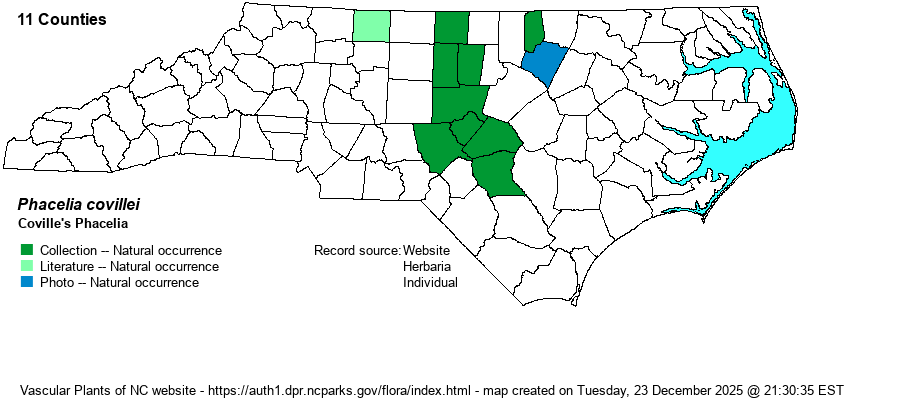| Author | S. Watson ex A. Gray | |
| Distribution | Essentially in the lower Piedmont and adjacent Coastal Plain, only on brownwater river floodplains, mainly along the Cape Fear River and its larger tributaries (Haw and Deep rivers). A recent (2023) photo record on iNaturalist from Stokes County extends the range much farther westward.
This species has a highly fragmented range, from MD and MO south to central NC. Main population areas are the Potomac River floodplain (MD and VA), the Cape Fear River (NC), and several tributaries of the Ohio River. It is not known from KY and TN. | |
| Abundance | Locally common to abundant along the Cape Fear River and its main branches upstream, from Cumberland County north into Alamance and Orange counties. Also, very local along the Tar River and tributaries at sites in Franklin and Vance counties, the Dan River in Caswell County (and Stokes County?), and one to several sites in the Neuse River drainage in Orange County. Absent away from such sites. This is a Significantly Rare species. | |
| Habitat | This species has the same habitats as, and often grows with, Nemophila aphylla. It is restricted to rich alluvial sediments along brownwater rivers and their larger tributaries; and it grows mostly on flats of bottomland forests and natural levee forests, less so on lower slopes of Basic Mesic Forests. |
| Phenology | Blooms mainly in April, somewhat later (by about two weeks) than does Nemophila, though both may be in bloom at the same place and time. It fruits in May, but dies back underground by mid- or late May. Thus, it is a spring ephemeral species. | |
| Identification | This is a very small and weak plant, with multiple branches such that it practically sprawls on the ground, even though it "attempts" to be an erect species. Plants can be 8-10 inches long, with scattered alternate leaves, each only about 1.5-2 inches long, excluding the long petiole. The blade is strongly dissected -- often to the midrib -- into 5-7 distinct lobes, more lobes than seen on Nemophila. Also, leaves tend to be blue-green and have purple spots along the margins, as opposed to bright green leaves of Nemophila. From some leaf axils and branch tips grow 2-5 flowers in a cluster, mostly just one in bloom at a time, being tiny, tubular, and pale blue to lavender and about 1/5-inch long, with only slightly spreading (5) lobes. Though it is a "rare" species globally and in NC, it can be so abundant, growing in huge stands of thousands of plants, that you may get tired of it if you walk enough bottomlands in the eastern Piedmont. Nonetheless, it has to compete with many exotic species that are taller or more aggressive, such as Microstegium vimineum, Stellaria media, and some others. | | Taxonomic Comments | Older references, including RAB (1968), named this species as P. ranunculacea. However, P. covillei was split off from that species, and the strict-sense P. ranunculacea is now found mainly along the Mississippi River, generally to the west of P. covillei.
| | | Other Common Name(s) | Buttercup Phacelia, Eastern Buttercup Phacelia. The first name was the long-used common name in our area, but as P. covillei was split off from that species and as "ranunculacea" refers to Ranunculus, the buttercup family, the name of Buttercup Phacelia must now be given to the strict-sense P. ranunculacea. | | | State Rank | S3 | | | Global Rank | G3 | | | State Status | SR-T | | | US Status | | | | USACE-agcp | FACW link | | USACE-emp | FACW link | |

